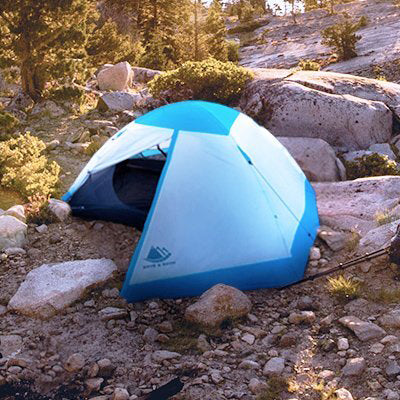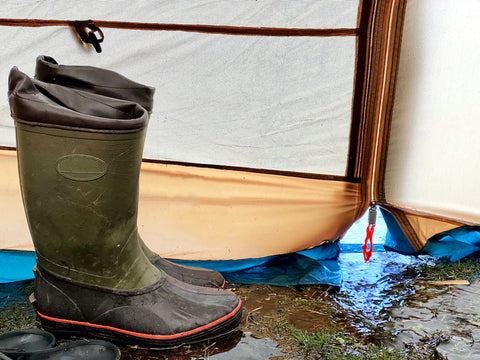Your Cart is Empty

When in the outdoors, your tent is your sanctuary. It shelters you from the rain, wind-borne debris, falling droppings, and critters. As a consequence, it accumulates dirt, mud, grime, and stains that can weaken its fabric, cause foul odors, and eventually cut short its lifespan. Keeping your tent clean will ensure it lasts many years and many trips and also help you drift off to sleep without worrying about uncomfortable smells.
If you’ve just completed your latest backpacking adventure or returned home from a camping trip with your family, follow these expert tips on how to wash a tent to get rid of mud, grime, bird droppings, tree sap, and other foreign matter that end up outside or inside your tent.
Keep reading to learn:
Let’s dive straight into it.

While it’s important to show your tent some love, that doesn’t mean you need to always be worrying about keeping it meticulously clean while you’re camping. That will take the fun out of your trip and ultimately take a toll on your tent. Still, tent care is essential.
The ideal time to clean your tent is immediately after a big camping trip or right after you take it out of storage (as it may have been exposed to dirt or dampness). Remember, the longer you wait to wash it, the more the dirt hardens, and it’s just a matter of time before the grime turns into tough stains.
However, if you go for a brief backpacking adventure and your tent still looks spotless, there is no need to clean it. Only wash it when it looks messy with caked-on dirt or mud. A good wash will remove any dirt buildup, kill mold growth, and eliminate musty smells, making your next camping experience much more comfortable.
While there is some debate on how often you should wash your tent, there is one thing the outdoor community agrees on: You should never put your tent inside a washing machine or dryer. These devices can stretch and tear the tent’s seam and mesh and wear down the waterproof coating. Also, never use a pressure washer, as there’s a good chance it’ll damage the tent’s delicate material.

Tents made from synthetic materials like nylon and polyester are loved by backpackers because they’re lightweight, easy to pitch, and pack small. Paired with ultralight sleeping pads, you never have to worry about your backpack getting too heavy.
Cleaning nylon backpacking tents is not a complicated process. The most important rule is to follow the manufacturer’s cleaning instructions. You can find that in the manual or on the care label sewn into the tent. Generally, synthetic tents are washed using the following approach.
First, get your supplies:
Steps for deep cleaning a soiled nylon tent:
If your tent is really muddy, greasy, or stinky, wait for a sunny day, take your tent and cleaning supplies outside and follow these steps.
Steps for spot cleaning your tent:
If your tent is generally clean apart from a few soiled areas on the exterior, use these steps.
If it’s been more than a year since you last waterproofed your tent, post-cleaning is the perfect time to coat it with waterproofing spray.
 a
aIf your tent is stored dirty or before drying properly or is exposed to damp conditions, it will fall victim to mold or mildew. Note that mold or mildew can appear in different colors such as black, blue, yellow, gray, or green isolated spots.
And the longer you wait to clean your tent, the more the mold or mildew grows, exposing you to harmful allergens and weakening your tent’s fabric. Fortunately, you can kill the fungi with a simple homemade solution.
First, get your supplies:
Steps to safely remove mold on a nylon tent:
If you’re a parent, why not teach your eager kids some backpacking tricks after giving your tent a good wash. Pitch the tent in the backyard and have some fun and games.
Canvas camping tents are made from cotton and will last a long time with proper care. However, they’ve been gradually replaced by synthetic tents because they are pretty heavy to carry if you’re hiking and camping. Cleaning them also isn’t as straightforward as other tent materials. Here’s how to wash your canvas tent.
First, get your supplies:
Steps for cleaning a dirty canvas tent:
Due to their cotton fabric, canvas tents are more susceptible to mold and mildew. Here’s how to purge the mold infestation.
First, get your supplies:
Steps for cleaning canvas tent mold:

Now you know how to wash a camping tent safely. But there is still a lot you can do to minimize how often your tent needs a major cleaning. In fact, preventing it from getting dirty in the first place is the best way to prolong its lifespan. Here’s how to keep your tent in pristine condition:
A tent is your home away from home when you go backpacking. But just because it’s built to withstand the unforgiving elements, doesn’t mean it should always look grubby. To keep it looking spotless and in pristine condition, take care of your tent when camping, clean it regularly (especially after long trips) and store it properly. With this approach, your trusty outdoor shelter will always be fresh and clean when you want to head off the beaten path.
Do you have any tent cleaning tips that we’ve missed? What are your thoughts on our tent cleaning process? Do you have another process that works for you? Feel free to drop a comment below. We really appreciate hearing from you.
Comments will be approved before showing up.